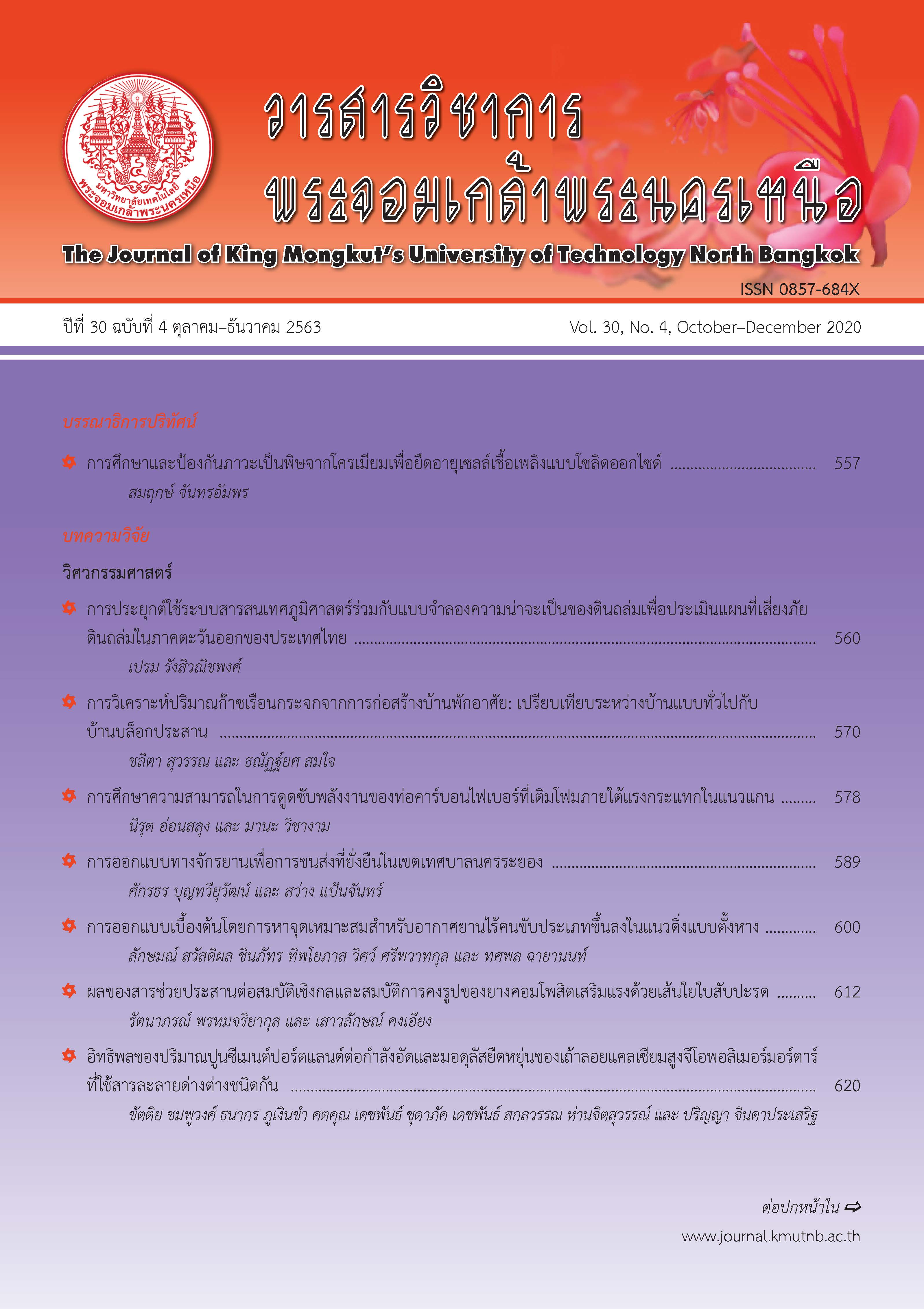การศึกษาและป้องกันภาวะเป็นพิษจากโครเมียมเพื่อยืดอายุเซลล์เชื้อเพลิงแบบโซลิดออกไซด์
Main Article Content
บทคัดย่อ
Solid Oxide Fuel Cell (SOFC) is a type of fuel cells – an electrochemical device that converts the chemical energy to electrical energy with relatively high efficiency and low greenhouse gas release compared with the conventional combustion engine [1]–[3]. This is because the cell efficiency is not subjected to the Carnot limit like the heat engine, and in the case that the fuel used is hydrogen the cell can generate electricity and give water as a by-product. The cell is called “solid oxide” because the ceramic, or solid oxide, is used to make the electrolyte, while the cathode is also ceramic and the anode is typically a composite of ceramic and metal [2]. As a consequence, the cell has to operate at relatively high temperatures e.g. about 800°C [3] to raise the ionic conductivity of the electrolyte for the practical use. In addition, at the high temperature service, the SOFC durability then becomes of paramount importance. The recent research on the SOFC technology assessment [4] has reported that the most important barrier to reducing the SOFC system cost, given by a group of interviewed experts, is the cost of the stack which mainly relates to the costs of materials and machinery. Moreover, the most considerable barrier to reducing the stack degradation was reported to be the Cr poisoning problem at the cathode [4]. The Cr poisoning occurs when Cr-containing materials e.g. ferritic stainless steels are used as an interconnect – the component used to separate a cathode of one cell from an anode of the neighbouring cell. At high temperatures, Cr in stainless steel reacts with the oxidising gas giving the Cr-containing oxide on the steel surface. If the cathode atmosphere contains water vapour in addition to the oxygen, these two gaseous species can help accelerate the volatilisation of the Cr-containing oxide giving the Cr volatile species which can further contaminate, or poison, the cathode material resulting in the degradation of the cell performance [3]. At the KMUTNB high temperature corrosion research centre, we have tackled the problem of the Cr poisoning with our partners from King Mongkut’s Institute of Technology Ladkrabang, Thailand, and the University of Grenoble-alpes, France. For the fundamental research, we constructed the experimental set-up to measure the Cr volatilisation from stainless steels oxidised at high temperatures especially in the atmosphere containing water vapour [5]. The effects of gas flow rate and different types of materials on the Cr-species volatilisation rate were investigated [5]–[7]. Furthermore, as a picture is worth a thousand words, we have proposed the graphical representation to visualise the mass flux of Cr loss from the Cr-containing alloys as a function of the water vapour content [8] based on the framework given by Young and Pint [9]. Apart from the basic work, the engineered surface treatment has been developed to combat the Cr poisoning by the pre-oxidation of stainless steel before the use at high temperature [7] or by the coating of Mn-Co spinel without and with the doping of some other elements [5], [8], [10]. The future research direction of the Cr poisoning effect is to adjust the coating parameters, without or with some beneficial doping elements in the coatings, in order to obtain the opitimised properties of the coated stainless steel interconnect i.e. the reduced Cr volatilisation and oxidation rates, the reduced area specific resistance, and the improved adherence of scale and the coating layer to steel substrate. Furthermore, many works evaluated the SOFC components at relatively short time periods while the expected lifetime of the SOFCs is up to about 40,000 h [3]. Thus the long-term exposure test should further been conducted. The translational research should also be emphasised to finally make the dream of production and distribution of the SOFC power generation system to our society come true.
Article Details
บทความที่ลงตีพิมพ์เป็นข้อคิดเห็นของผู้เขียนเท่านั้น
ผู้เขียนจะต้องเป็นผู้รับผิดชอบต่อผลทางกฎหมายใดๆ ที่อาจเกิดขึ้นจากบทความนั้น
เอกสารอ้างอิง
[2] N. P. Brandon, E. Ruiz-Trejo, and P. Boldrin, Solid Oxide Fuel Cell Liftime and Durability Critical Challenges in Fuel Cells, UK: Academic Press, 2017, pp. 1–18.
[3] S. Chevalier, L. Combemale, I. Popa, S. Chandraambhorn, W. Chandra-ambhorn, P. Promdirek, and P. Wongpromrat, “Chapter 6 development of SOFC interconnect stainless steels,” in Solid State Phenomena, vol. 300, pp. 135–156, 2020.
[4] M. M. Whiston, I. M. L. Azevedo, S. Litster, C. Samaras, K. S. Whitefoot, and J. F. Whitacre, “Meeting U.S. solid oxide fuel cell targets,” Joule, vol. 3, no. 9, pp. 2060–2065, 2019.
[5] W. Wongpromrat, H. Thaikan, W. Chandra-ambhorn, and S. Chandra-ambhorn, “Chromium vaporisation from AISI 441 stainless steel oxidised in humidified oxygen,” Oxidation of Metals, vol. 79, pp. 529–540, 2013.
[6] A. Galerie, M. R. Ardigo, P. Berthod, W. Chandraambhorn, S. Chevalier, P. Y. Hou, and F. Rouillard, “Chapter 1 Influence of water vapor on hightemperature oxidation of chromia forming materials,” in French Activity on High Temperature Corrosion in Water Vapor, Switzerland: Trans Tech Publications, 2014, pp. 1–25.
[7] W. Wongpromrat, G. Berthomé, V. Parry, S. Chandra-ambhorn, W. Chandra-ambhorn, C. Pascal, A. Galerie, and Y. Wouters, “Reduction of chromium volatilisation from stainless steel interconnector of solid oxide electrochemical devices by controlled preoxidation,” Corrosion Science, vol. 106, pp. 172–178, 2016.
[8] T. Thublaor and S. Chandra-ambhorn, “High temperature oxidation and chromium volatilisation of AISI 430 stainless steel coated by Mn-Co and Mn-Co-Cu oxides for SOFC interconnect application,” Corrosion Science, vol. 174, article 108802, 2020.
[9] D. J. Young, and B. A. Pint, “Chromium volatilization rates from Cr2O3 scales into flowing gases containing water vapor,” Oxidation of Metals, vol. 66, pp. 137–153, 2006.
[10] W. Kanyarat, P. Limprapard, T. Siripongsakul, S. Chandra-ambhorn, P. Visuttipitukul, and K. Taweesup, “Electroplating Ni-doped Mn-Co films on AISI 430 stainless steel as interconnects in solid oxide fuel cells (SOFC),” Materials Testing, vol. 59, pp. 951–956, 2017.

